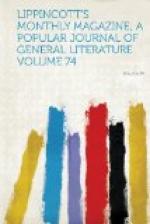a scene from
Andromaque: he is so bad, so
very
bad, that the audience are moved to sudden outbursts
of hilarity by his grand tragic points. He is
succeeded by a boy of sixteen, tall and graceful,
with a fine tragic face of the heroic Kemble mould,
and great blue-gray eyes that dilate or contract beneath
the impulses of the moment—a born actor
from head to foot. He fairly thrills the audience
in the great scene of the duke de Nemours from
Louis
XI. This youth, M. Guitry, is undoubtedly,
if his life be spared, the coming tragedian of the
French stage. Then we have the first one of the
lady competitors, Mademoiselle Edet, a tall, awkward
girl of eighteen, with a flat face and Chinese-like
features, dressed up in a gown of cream-yellow foulard
trimmed with wide fringe and made with a loose jacket,
whereon the fringes wave wildly in the air as she
flings her arms around in the tragic love-making of
Phedre. Two or three others of moderate merit
succeed, and then comes Mademoiselle Jullien, who
gives the great scene of Roxane in
Bajazet
with so much intelligence of intonation and grace of
gesture that the audience are moved to sudden applause.
She is rather too short and of too delicate a physique
for tragedy, but her face is expressive, her eyes
fine, and there are intellect and talent in every tone
and movement. She is nearly twenty-nine years
of age, so has not much time to waste if she is to
make her mark in her profession. Last on the list
of tragic aspirants comes a gentleman of thirty-one,
M. Aubert, who goes through a scene from
Hamlet
in a very tolerable manner. He was in the army,
was doing well and was rising in grade when, seized
by the theatrical mania, he relinquished his profession
and turned his attention to the stage. Thus far,
he has proved, practically speaking, a failure:
he has won no prizes, and no manager will engage him.
This is his last chance, as his age will prevent him,
by the rules of the Conservatoire, from taking part
in any future competition.
The tragedy concours ended, a recess of an hour is
proclaimed, and there is a rush to the refreshment-tables
and a great consumption of sandwiches and cakes, of
coffee and water (known as “mazagran”)
and of vin ordinaire. Under that vestibule
pass and repass the literary luminaries of modern
France. Here is Henri de Bornier, the author of
La Fille de Roland, a quiet, earnest-looking
gentleman, with clear luminous eyes and the smallest
hands imaginable. Here comes Francisque Sarcey,
the greatest dramatic critic of France and one of
the most noted of her Republican journalists, broad-shouldered,
black-eyed and stalwart-looking. Yonder stand
a group of Academicians—Legouve, Doucet,
Dumas—in earnest conversation with Edouard
Thierry, the librarian of the Arsenal. The handsome,
delicate, aristocratic-looking gentleman who joins
the group is M. Perrin, the director of the Comedie
Francaise, the most accomplished and intelligent theatrical




